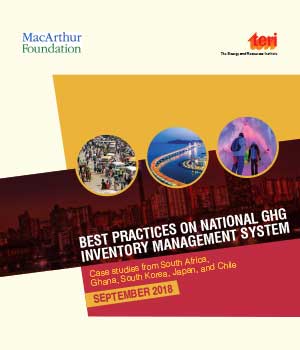
The Paris Agreement established a Transparency Framework in order to build mutual trust and confidence and to promote effective implementation, an enhanced transparency framework for action and support, with built-in flexibility which takes into account Parties' different capacities.
and builds upon collective experience. As per Article 13, paragraph 7(a), of the Paris Agreement, each Party will regularly provide a national inventory report (NIR) of anthropogenic greenhouse gas (GHG) emissions by sources and removal by sinks, prepared using good practice methodologies accepted by the Intergovernmental Panel on Climate Change (IPCC) and agreed upon by the Conference of the Parties serving as the meeting of the Parties to the Agreement (CMA).
The national GHG inventories provide the foundation for tracking progress towards the Nationally Determined Contributions (NDCs). A complete and transparent national GHG inventory is an essential tool for understanding emissions and trends, projecting future emissions and identifying sectors for cost-effective emission reduction opportunities. A national inventory is also a core element of national communication reports to the United Nations Framework Convention on Climate Change (UNFCCC).
A national GHG inventory system creates a process for documenting the procedures and processes involved in estimating GHG inventories and ensuring that data, information, and assumptions are reported and archived. Robust national inventory systems also include quality assurance and quality control (QA/QC) measures and introduce legal and institutional mechanisms for ensuring periodic reporting of necessary data. Thus, an inventory system comprises both the documentation of the GHG inventory itself (i.e., what was calculated, how, and what does it mean) as well as documents “around” the inventory describing how to make an inventory, e.g., work plans, manual of procedures, legal and organizational basis, responsibilities, reporting obligations, etc. (UNDP, 2005).
The reporting and review procedures and requirements can be challenging for participating governments. The most common constraints reported by developing countries in this context include lack of adequate archiving and management of data; application of quality assurance/quality control (QA/QC) procedures in inventory compilation; procedures to fill data gaps; and use of methodologies to assess uncertainties of GHG inventories, among others.
The compendium elucidates on the background and insights on Best Practices on National Inventory Management System followed in five countries (South Africa, Ghana, South Korea, Japan, and Chile). The document extensively clarifies on the demographical background, geographical conditions, energy profile, institutional frameworks, environmental conditions & effects, key challenges, methodology adopted for estimation of GHG inventory, preparatory processes, and policies pertaining to the environment for the five countries. The publication also documents the best and simple methodological approach adopted by these five nations in developing the national inventory management system, in turn helping the developing countries to adopt the same practices in estimating their GHG inventories.
